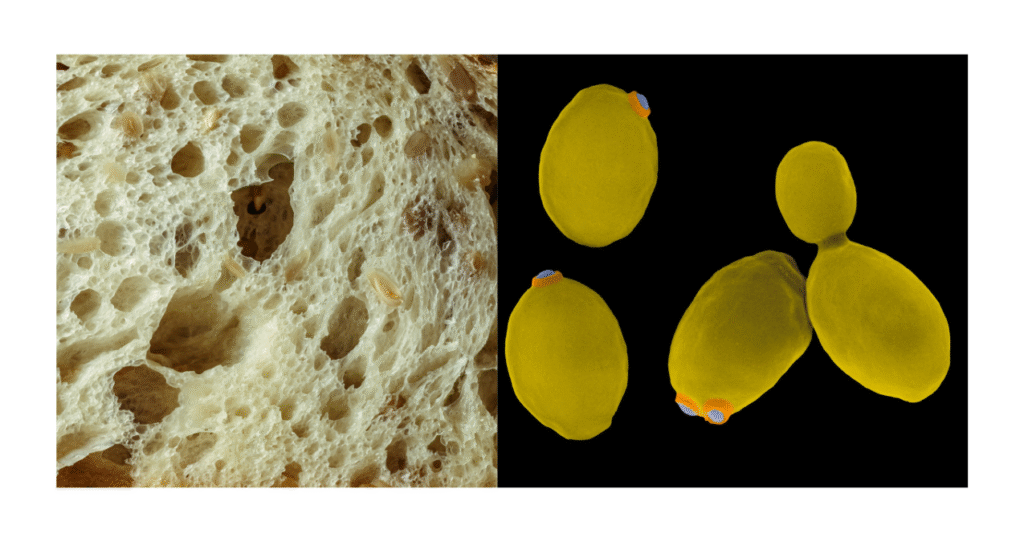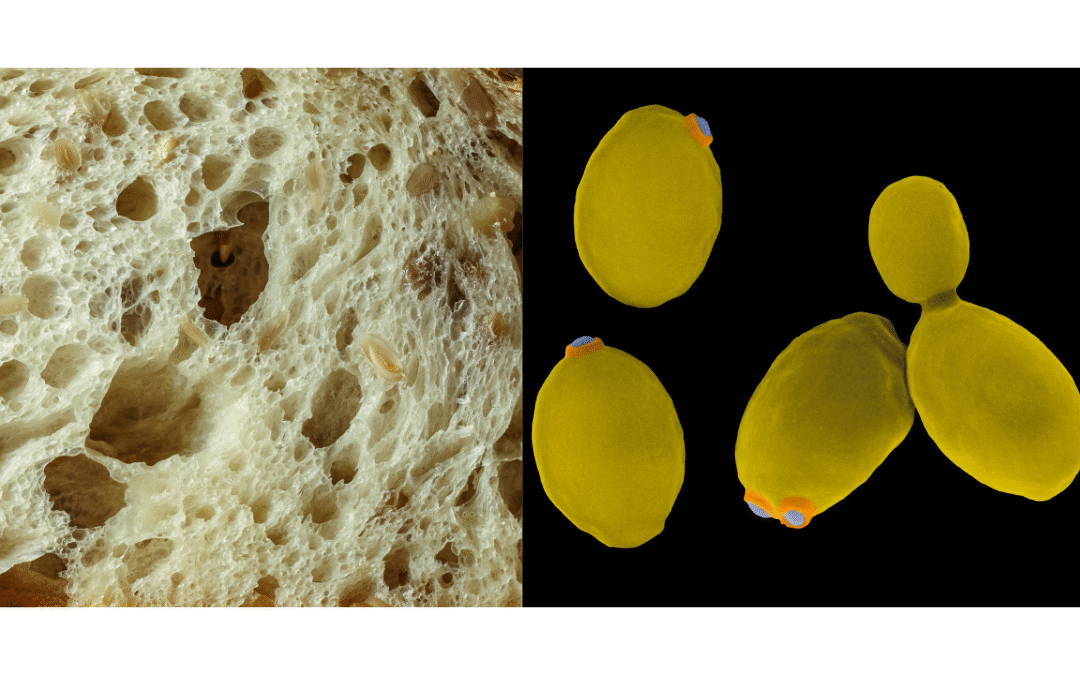
On the left: the result of a perfect fermentation. On the right: the protagonists responsible for the process, Saccharomyces cerevisiae yeast.
#IngredientsUnderTheLens
The yeast dosage is one of the most critical and feared topics in the world of leavened goods. It’s a seemingly simple act that, when managed with scientific awareness, determines the success of an open, airy crumb. When left to chance, however, it leads to a disappointing, collapsed product.
It’s a suspended moment, a small “act of faith” that brings with it a “scale anxiety” we all know. It’s those few grams that decide the fate of hours of work. They can lead to the success of a beautifully open structure, or the disaster of a collapsed and disappointing bake.
Today, I want to invite you to take a step back from the recipe to take a leap forward in awareness. To overcome this fear, we must stop thinking of yeast as an inert ingredient and start seeing it for what it is: a population of living organisms.
In this deep dive, we will put on our biologist’s lab coats to understand how to govern this population. Because to become masters of our dough, we must stop “following a dose” and start “managing a biological process.”
Beyond Yeast Dosage: Cell Density and Vitality
The first paradigm shift is this: we must stop thinking in terms of “grams of yeast” and start thinking in terms of initial cell density.
When we inoculate the yeast—whether it’s commercial yeast (fresh or dry) or a sourdough starter—we are introducing a population of microorganisms, mainly Saccharomyces cerevisiae, into a new, nutrient-rich environment. Our goal isn’t just to “add yeast”; it’s to achieve an optimal density of yeast cells for the result we want, in the time we have, and at the temperature of our lab.
Fresh commercial yeast has a very high concentration of live, vital cells. Active dry yeast needs to be rehydrated to “awaken” the cells. A sourdough starter is a complex ecosystem with a lower density of Saccharomyces and in competition with lactic acid bacteria. You can see why “5 grams” cannot have the same biological meaning in these three cases.
Lag, Log, and Stationary: The 3 Phases of the Party (Explained by Biology)
The life of Saccharomyces in our dough follows a predictable growth curve, which biologists divide into three main phases. And yes, the party metaphor is surprisingly accurate.
- Lag Phase – The Guests Settle In: Once inoculated, the yeast cells don’t immediately start fermenting at full speed. They must adapt to the new environment: the osmotic pressure, the pH, and the availability of oxygen and nutrients. This is the phase where the guests arrive, take off their coats, see where the buffet is, and decide if they like the music. A lag phase that is too long is a sign of weak cells or an inhospitable environment.
- Logarithmic (Log) Phase – The Party Takes Off: Once adapted, the cells begin to reproduce by budding at an exponential rate, metabolizing the simple sugars in the flour. This process has two well-known outcomes: the production of ethanol and, above all, carbon dioxide ($CO_2$). It is this gas that gets trapped in the gluten network and makes the dough rise.
- This is where initial density makes all the difference. An excessive inoculum (too many guests) leads to a log phase that is too fast and violent. The buffet (sugars) is consumed too quickly, gas production is tumultuous, and the still-immature gluten network cannot contain it and tears. The dough collapses. Furthermore, excessive production of alcohol and other secondary metabolites compromises the aromatic profile, creating the classic “yeasty” smell.
- A scarce inoculum (too few guests) leads to a slow and weak log phase. The $CO_2$ production is insufficient to create volume and structure before other processes (e.g., excessive acidification by other microorganisms) take over.
From Growth to Decline: The Stationary Phase
- Stationary Phase – The Party Winds Down: Resources begin to run out, the dough’s pH has dropped, and the ethanol concentration becomes almost toxic to the yeast itself. The reproduction rate slows down until it equals the mortality rate. Gas production ceases. If we push fermentation too far, we enter the decline phase, with cell death and the potential release of unpleasant compounds (like glutathione) that damage the gluten.
From the Microscope to the Lab: Rules for a Perfect Yeast Dosage
Understanding the biology is one thing, but how do we translate it into concrete actions?
- Standardize Your Yeast: Choose one type of yeast and get to know it thoroughly. If you use commercial yeast, ensure it’s always fresh and stored correctly. Even if it’s dry (dehydrated), you must always know it well. If you use a sourdough starter, maintain it with regular feedings to ensure constant vitality and microbial density.
- Temperature is Your Accelerator: Temperature is the most powerful external factor we have for regulating the speed of yeast metabolism. An empirical rule (a simplified version of “van ‘t Hoff’s rule” for us bakers) states that for every ≈10°C (18°F) increase, the metabolic reaction speed doubles. This means the same dose of yeast at 28°C (82°F) will work about twice as fast as at 18°C (64°F). Controlling the dough temperature is crucial.
- Adapt the Dose to the Time: There is no universal yeast dosage; there is only the right dose for the time you have. Do you want a 2-3 hour rise at room temperature? You’ll need a relatively high inoculum (e.g., 2-3% fresh yeast based on flour weight). Do you want a long, 24-48 hour cold fermentation in the fridge? The inoculum must be drastically reduced (e.g., 0.1-0.3%).
The Bottom Line: The 3 “T’s” to Remember
To govern the Saccharomyces party, remember these three “T’s”:
- TYPE (of yeast): Its vitality and cell concentration is your starting point.
- TEMPERATURE: This is your accelerator or brake pedal for metabolism.
- TIME: This is the final goal to which the other two variables must adapt.
Mastering these 3 “T’s” is the true secret to a conscious yeast dosage no longer based on fear, transforming scale anxiety into pure technical control.
Stop fearing Saccharomyces. They are our most powerful and trusted allies. We just need to learn to speak their language: the language of biology. Only then can we orchestrate doughs that are not only beautiful to look at, but also balanced, digestible, and aromatically complex.
With method and passion,
Katia Oldani
Biologist Pastry Chef


